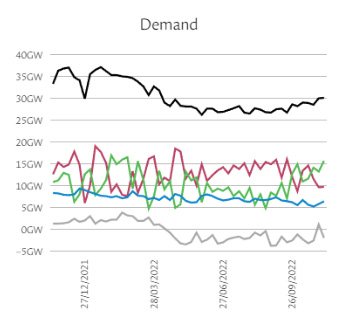2022 Autumn Statement
17TH NOVEMBER 2022
Energy Efficiency finally becomes government policy
The 2022 Autumn statement, delivered today, finally recognises energy efficiency as being a key requirement to address the current challenger, page 3 of the statement reads “the government is setting a national ambition to reduce energy consumption by 15% by 2030, delivered through public and private investment, and a range of cost-free and low-cost steps to reduce energy demand”
We hugely welcome this approach, which is more than achievable and look forward to details coming forward on the governments investment into this. It is of some concern that the BIES departmental budget projections for capital funding from 22/23 to 24/25 show no increase in funding nor does the promised £6bn feature in the policy decisions tables at the end of the Autumn Statement documents.
Energy Windfall Tax
The government has announced an increase in the energy companies windfall tax from 25% to 35% and an additional temporary levy on electricity generators of 45%. This is a sensible action given that the governments support to consumers, running to many tens of billions (£43bn in 22/23 and £25bn in 23/24), is basically ending up funding the exceptional profits of gas and electricity generators. It should be noted that the windfall tax is only forecast to bring in £9.3bn in 22/23 and £18.3 bn in 23/24 meaning that the government is essentially funding £33.7bn in excess profits to energy companies in 22/23 and £6.7bn in 23/24). We would like to see more work put into structural energy market reform that seeks to break the connection between gas prices and electricity prices.
Energy Price Support
It was announced that the Energy Price Guarantee for domestic consumers will be extended from April 2023 to April 2024 at a higher level of £3,000 for the average household (compared to the current £2,500 EPG). Therefore consumers can be expected to see a 20% increase in their energy bills from April 2023.
The government also announced that it will provide £200 this winter for households that use oil, LPG, coal or biomass for their heating. It also announced that it will provide £150 to all UK non-domestic consumer who are ‘off gas grid’ and use oil, LPG etc.
This support has to be welcomed and being necessary to support many struggling with the cost of energy but it is notable that the support still has no means testing element within it. The government should be encouraged to push ahead with urgent energy market pricing structure reforms to reduce the costs of energy (especially electricity) before April 2024 so that this support is no longer required.
The budget announced that the business Energy Price Relief Scheme review will be published by 31 dec 2022 and detail what support may be provided beyond the end of the current scheme at the end of March 2023. It notes that the support with be “significantly lower” than the current support and therefore energy costs for non-domestic users, including charities and the public sector remain a huge concern.
EV road tax
EV’s will now have to pay road tax from April 2025. This was widely expected and would seem fair given the EVs use the roads in the same way as other road users. This will be £10 for the first year and then £165 per year thereafter which is the ‘standard rate’. This will include EVs first register from 1st April 2017. This measure will bring in an additional £515m in 25/26 increasing to £1.6bn by 27/28.
There will continue to be advantageous company car tax rates for EVs when compared to other vehicles.
The Government must reconsider these rates and look to set the level of road tax for EVs at a level well below that of petrol and diesel cars (possibly by increasing the tax for ICE vehicles) to ensure that the growth in the uptake of EVs continues. The government should also commit to the full exemption for EVs in any air quality zones nationwide and encourage EV discounts on other road charging such as bridge and tunnel tolls such as the Dart Crossing and the M6 toll.
Climate Change Levy
The Autumn Statement confirms that the rates for CCL, which apply to all business energy bills, will be equalised between gas and electricity by 2025. This means that the CCL rates for future years will be as shown in the table below and will bring in an additional £85m per year to the treasury.

This will mean the electricity CCL rates will remain unchanged from currently levels and CCL rates for gas will increase by 36% over the next 18 months. It is therefore important that any organisations which can claim exemptions (for domestic use such as student accommodation and non-business charitable use such as schools and churches) complete a VAT declaration and send it to their energy suppliers.
Energy Generation
The Government has stated that it remains committed to investing in nuclear (at Sizewell C) and the roll out of wind and solar. The budget states the government’s commitment to decarbonise the UK’s electricity supply by 2035 but caveats this with a comment that this is subject to security of supply.
While it is welcome and pleasing to see in a budget where all too frequently energy has not been considered it would be welcome to see further promotion of onshore wind developments and the rapid development of a hydrogen production industry in the UK to support the security of supply issues.
Energy Efficiency
The government announced a target to reduce the UKs energy consumption, across both domestic and non-domestic users, by 15% by 2030 (based on 2021 consumption levels). This is entirely achievable and in many respects is a very soft target.
Figures show that electricity demand has already reduced significantly from 2021 where typical demand levels of around 35GW were evident. These are now less than 30GW suggesting that the increase in energy prices, which has resulted in a much greater awareness of consumers in energy efficiency, has already delivered this 15% reduction. A target of a 30% reduction would therefore be more sensible and would remain realistic.

Source: http://grid.iamkate.com
£2bn of funding per year is going to be insufficient to delivery the ‘easy’ energy efficiency measures that exist. A recent study by Inspired Efficiency found that schools alone have £2,5bn of simple energy efficiency measures that could be implemented in the short term, with the major element being the conversion of LED lighting. Only 31% of existing lighting fittings within schools are LED with the remaining circa 70% being suitable for converting to the much lower energy consuming LED units. This would seem to be typical across the wider public estate and also other non-public sector estates.
The energy profits levy is bringing in around £6bn per year up to 25/26 and this level of investment is more in line with the investment levels required in energy efficiency (excluding decarbonisation through PSDS)
Overall this Autumn Statement can be seen as positive in finally provide some recognition to the importance of energy policy and energy efficiency in delivering this however it fails to provide sufficient financial investment in this area (especially compare to investment in other areas such as road and rail) and it fails to continue to use government taxation policy to nudge society to be more energy and carbon efficient. A positive small step forward but a long way still to go.
Please contact Matt Fulford for further information on matt@inspiredefficiency.co.uk – 07971 787363.
Latest News & Views.
Feast and Famine
Schools, and the rest of the public sector, in England are currently left with no available funding to pay for energy efficiency and carbon reduction works
A Green Budget?
The March 2021 budget, titled “Protecting the Jobs and Livelihoods of the British People” was a major opportunity for the Chancellor to kick start the green recovery following COVID
Public Sector Decarbonisation Scheme Round 2 (or is it?)
Phase 2 of the Public Sector Decarbonisation Scheme has been announced on 17th March 2020 with applications open for submission on 7th April
The Public Sector Wants to be Net Zero
When the Public Sector Decarbonisation Scheme was launched at the end of September, £1bn of funding needing to be spent on projects in well under a year and with only a few months to prepare applications sounded like a challenge…
